|
|
COVID has upended status quo to create new business realities, making enterprises and organizations rethink, relook, and redefine – not just their strategies, but also their organizational structures. Shared Services, which was till now looked at as a siloed business unit, is now being redefined, to drive collaboration, agility, and innovation. A seismic shift is underway with technology acting as the catalyst and giving rise to multi-functional Global Business Services (GBS) organizations, or GBS 2.0.
How has the GBS landscape evolved over the last decade?
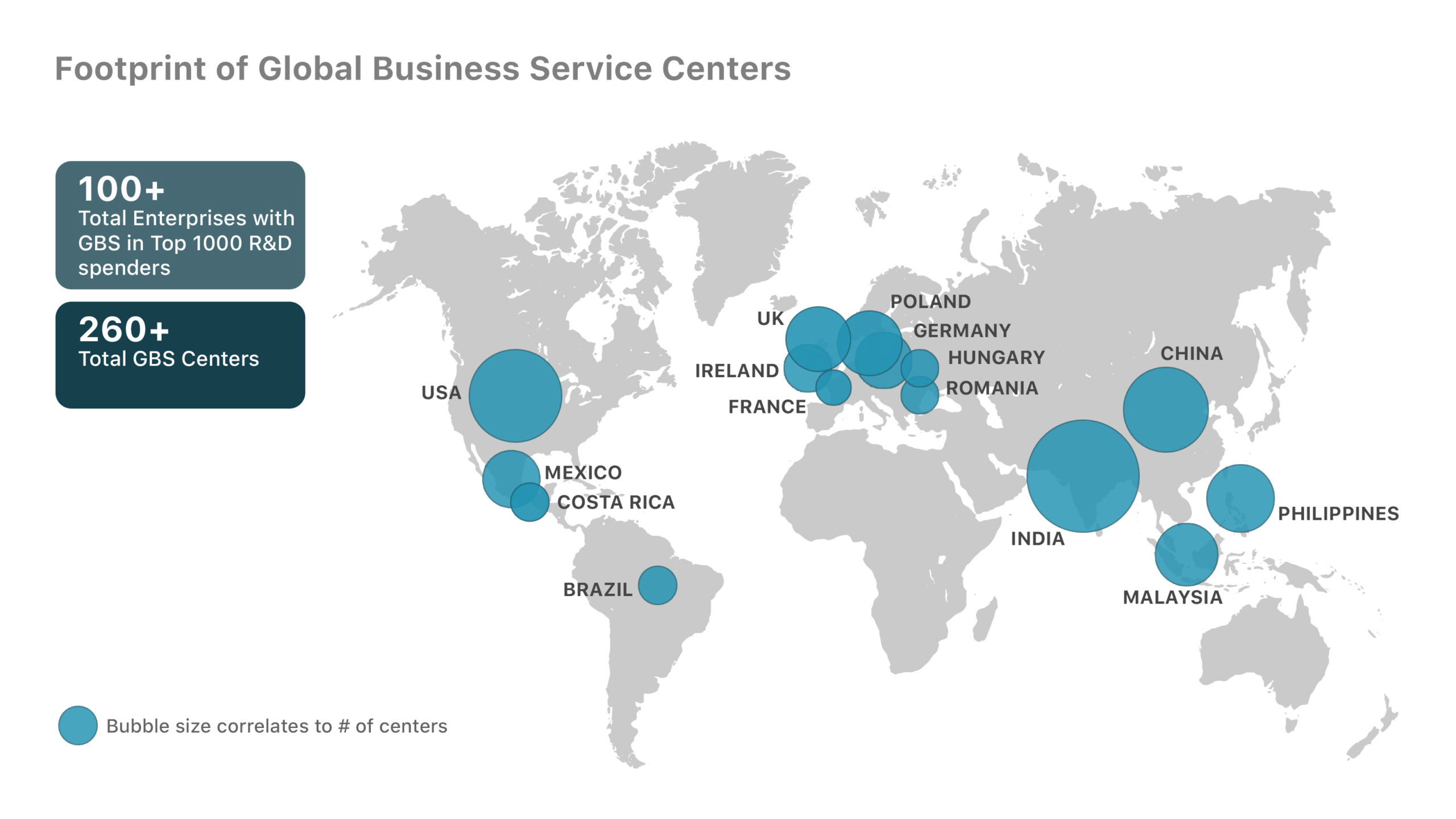
When we analyzed the top 1000 companies with the highest R&D and technology spend – Z1000 database – we found that only 10% of them have formal GBS organizations. While some of them have set up nearshore centers, others are leveraging offshore centers in locations across the US, Asia, Europe, and Latin America. Even some GBS organizations have partnered with third-party vendors. Due to the pandemic, these centers underscored the fact that they can operate efficiently from anywhere, potentially resulting in more work being transitioned from onshore to nearshore locations such as Mexico and Costa Rica. Interestingly, most companies have transitioned from single-function GBS to multi-function GBS organizations. This natural progression will continue in the future.
After a decade of evolution, GBS organizations are at a crossroads, where they are faced with numerous challenges, alongside unique opportunities.
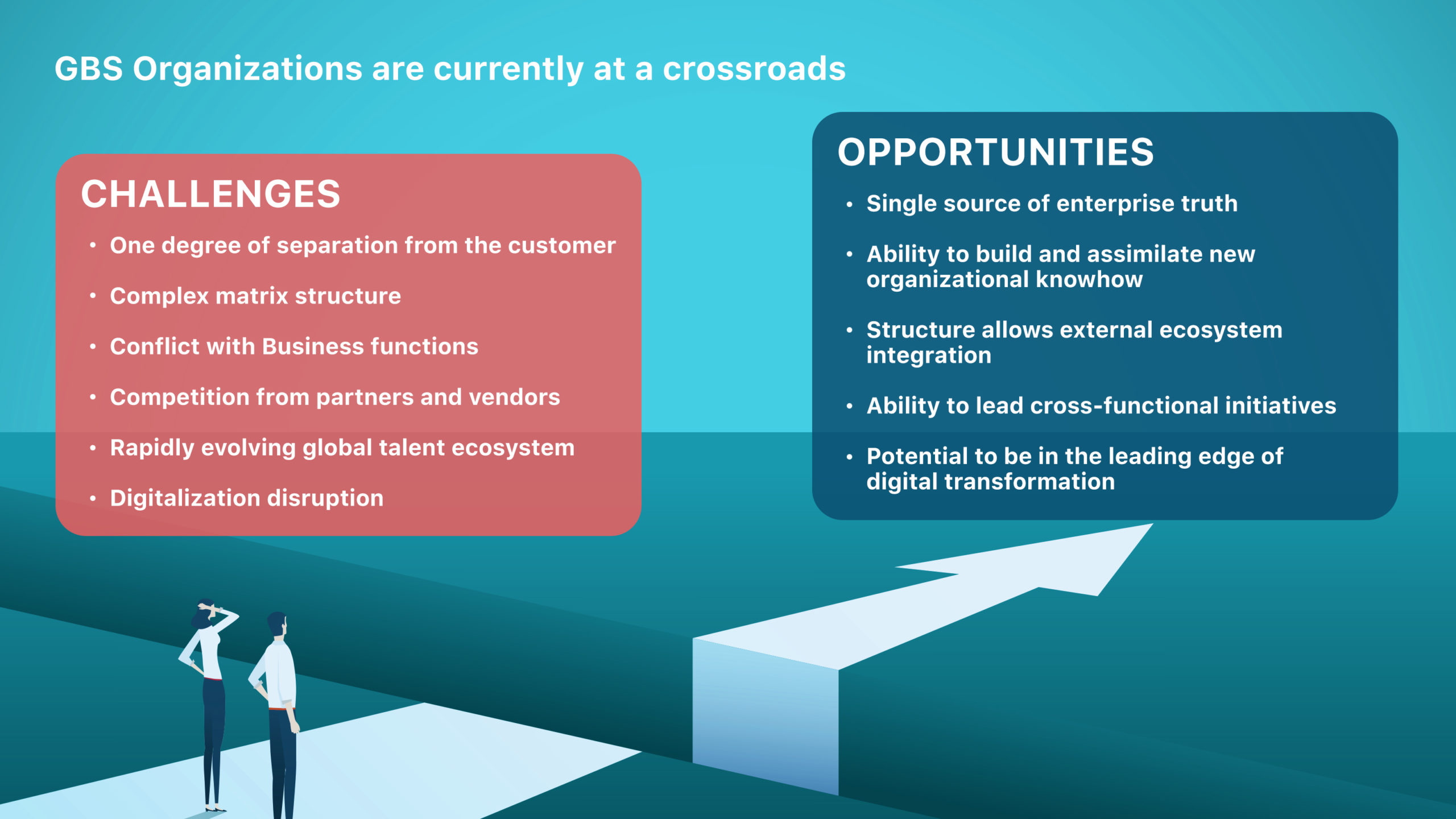
In today’s age of high-touch customer experience, companies are trying to reduce the number of levels between the customers and their teams. However, Global Business Services adds another layer of separation, making it hard for teams to understand their customers’ needs.
GBS team structures resemble neither Services Companies nor are they set up as a part of the corporate functions. Instead, they have complex matrix structures since they operate as a service provider to the larger organization, thereby creating multiple layers of service structure within the GBS organization.
As GBS teams mature within a company, they want more ownership of the functions they are responsible for, including some corporate function transformation initiatives. If these are not aligned with corporate priorities, it creates conflicts with the corporate functions.
GBS teams are competing with their own partners and vendors; they are at risk of being taken over by third-party service providers, who want to increase their revenue and stickiness with the customer. Such scenarios are more common in times of crises like COVID-19.
2021 will be the year of talent wars across global locations. With remote work being embraced across the world, companies are now competing for skilled talent from anywhere in the world. To put things into perspective, consider these numbers. Our Draup research shows that the need for Artificial Intelligence talent is close to 1.2 Mn engineers, while the currently deployed talent is only about 650K.
On the flip side of the ongoing talent war is the massive wave of Hyper Intelligent Automation (HIA) disrupting the roles supported by GBS organizations. GBS teams that measure their value on revenue generation and headcount supported, will have a hard time keeping automation at bay.
1. GBS is the arbiter of organizational processes, exceptions, and treasure troves of data. In fact, GBS is the single source of enterprise truth that CXOs can rely on, making it the core of the organization.
2. GBS is in a unique position to build new organizational knowhow. For example, if the company wants to experiment with say, Blockchain, GBS with technology and operations capability can deploy new use cases as well as build blockchain capability leveraging its global reach and partner network.
3. GBS structure allows it to target and engage the external ecosystem of partners, innovative start-ups, and academia to bring in new innovations and seamlessly integrate them within the organizational processes. This reduces the change management challenges that arise when corporate functions try to do this themselves.
4. GBS is in the unique position to drive cross-functional initiatives within the organization since all functions have representation within the GBS organization.
5. Similarly, GBS can also be central to the organization’s digital transformation initiatives.
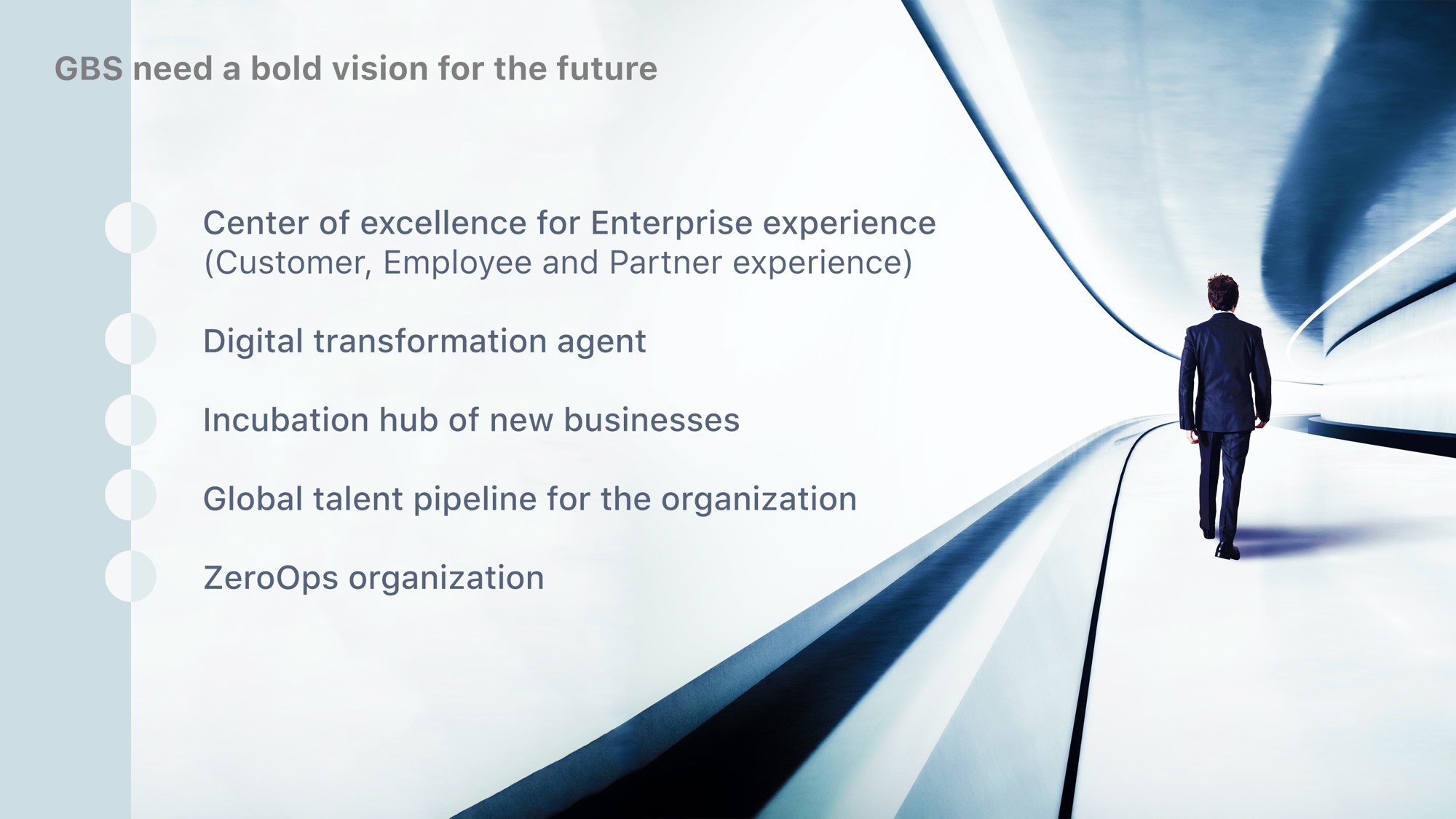
We believe that the above-mentioned opportunities outweigh the challenges, as GBS organizations transition into GBS 2.0 and step into the next phase of their evolution. To be successful in this transition and capitalize on the opportunities, GBS organizations need a bold vision. First and foremost is realigning the GBS organizations’ vision to enable enterprise experience, rather than merely reducing the cost of operations. GBS organizations should take the onus of enabling the enterprise to excel in customer experience, employee experience, and partner experience – which are the core of any company’s competitive advantage.
Since GBS organizations are in the unique position of being arbiters and orchestrators of organizational processes and tons of data, they should be the digital transformation agents of the company. GBS should be the place where new technologies are incubated in partnership with IT and business units, and rapidly scaled to create enterprise-level impact. Additionally, GBS organizations should also explore the creation of new digital and digitally enabled business opportunities for the enterprise. The large repository of technology, data/insights, and process knowhow that GBS organizations possess, can be packaged into service offerings for other customers.
Since GBS teams work horizontally, across the company, they should take on the responsibility of grooming top talent and also work on creating a talent pipeline of domain experts and leaders. More importantly, GBS organizations should take on the mandate to enable the company to compete with digital native companies. One of the key differentiations that digital native companies boast of is their ability to operate with nearly zero manual intervention in operations. GBS organizations of the future should envision and execute a ZeroOps Enterprise Strategy.
For GBS organizations to execute on the bold vision laid out in the previous section, they need to be anchored on 5 key pillars – Portfolio Allocation, Global Centers of Excellence, Hyper Intelligent Automation, Intrapreneurial Leaders, and Innovation Pipeline. These will become critical levers of growth and transformation for the organization in the post-pandemic reality.
How a project or work portfolio gets allocated within GBS is critical. Instead of breaking down processes by tasks and skills, end-to-end processes should be allocated to a specific location or a Service Provider. Process transition by task is an archaic model since it doesn’t easily allow process re-engineering and deployment of technologies such as AI and automation.
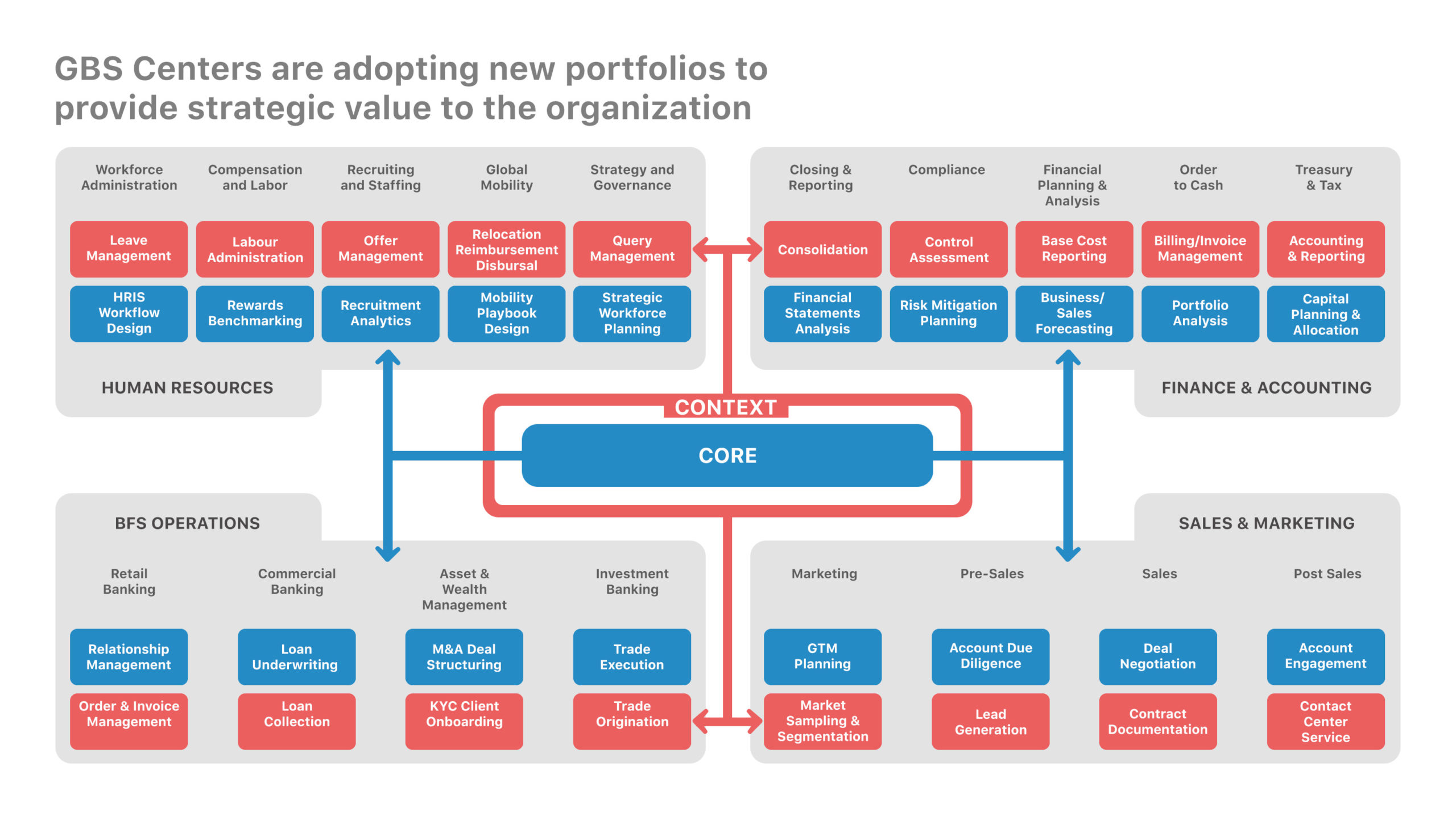
A deep understanding of core vs context will also help in allocation. Core processes are what differentiates a company from their peers. For example, in this era of talent wars, companies should keep core HR processes that touch candidate experience in-house, while outsourcing processes that are purely administrative in nature.
GBS organizations should transform their captive units into Global Centers of Excellence. These fully owned subsidiaries should act as a source of great talent, technology, and process capabilities. Additionally, the time to call a company’s own centers as Captive Centers is passé; they are not captive to anyone. They should be transitioned and empowered into centers of excellence.
Here’s the operating model leveraged by best-in-class centers of excellence.
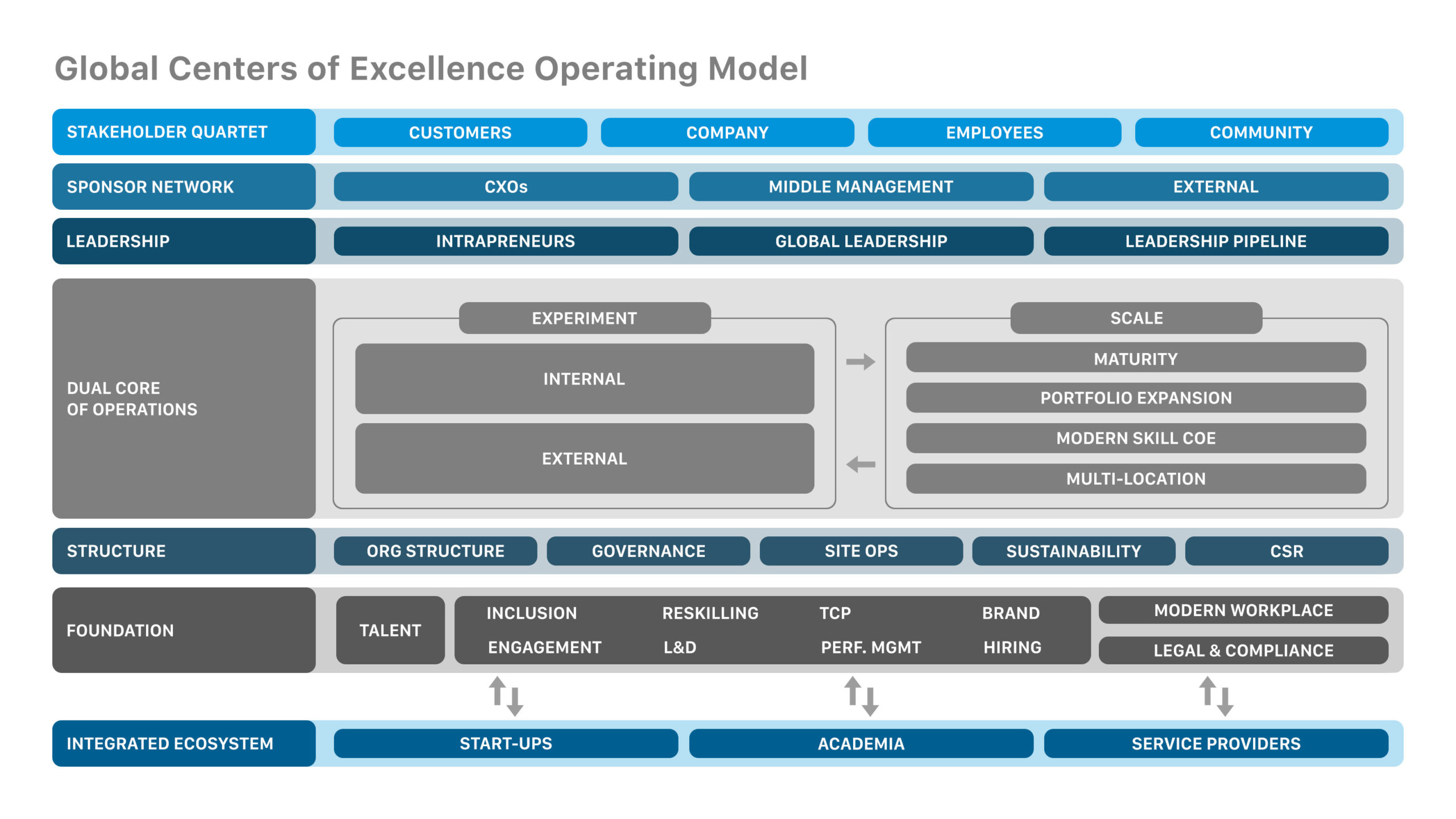
A GCoE has four key stakeholders – the customers, the company, the employees, and the community. Most GCoEs optimize only for their company and become a tactical tool to achieve a specific goal, which loses its relevance post that. However, when all four stakeholders are prioritized, an institution is built rather than a fragile organization.
GCoEs should have a sponsor guild across CXOs of various functions, global mid-level leaders with whom the teams work daily, and external sponsors in the government and other parts of the ecosystem. This will ensure that the system won’t break when the primary sponsor leaves the company.
GCoEs are driven by a dual core than a single core. The first core is the experiment core, which has a set of intrapreneurs who are willing to take small risks and experiment as well as learn from ideas. Although most of these ideas could potentially fail, they need to have the right system in place to sustain. The second core is the scale core, which has two functions – one is to expand the global project portfolio and maturity, while the second is to scale the successful experiments from the experiment core.
GCoEs are tightly integrated with the external ecosystem comprised of start-ups, academia, and technology Service Providers to augment the efforts across both cores.
GBS should embrace the possibilities of Hyper Intelligent Automation to go past the innovator’s dilemma and focus on intentional cannibalization of the GBS portfolio. The right set of capabilities is critical to take a holistic approach to automation.
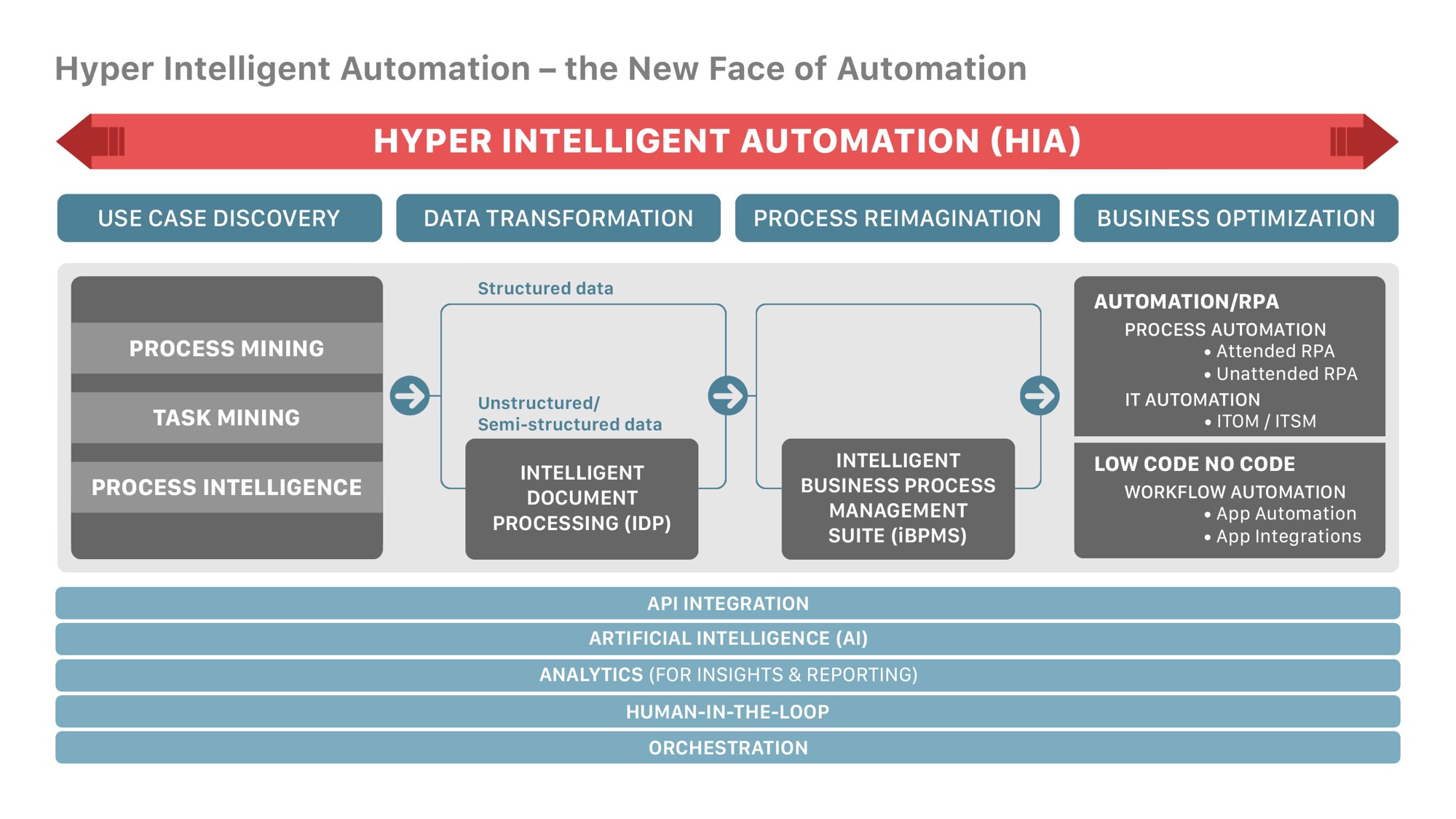
The GBS leader who takes on the role of an Automation Czar will help the GBS organization lead from the front. Also, to bring in more structure to the company’s automation focus and build HIA organizational muscle, it is crucial to set up an automation center of excellence (COE). A dedicated COE can be run effectively by the collaborative effort between IT and Business, where IT is responsible for governing and managing automation deployment, while Business fuels the automation projects with domain expertise. For this COE to be successful, the Automation COE should have the right consulting as well as implementation expertise. A data science team, housed within the COE, can help tap into GBS domain expertise to drive Machine Learning-led automation.
As essential as it is to build technological muscle, it is equally important for the GBS to define and foster a culture of innovation. GBS organizations should build the right set of structures and processes to systematically create an innovation pipeline that drives value for the GBS as well as the enterprise.
“Innovation is about turning a new idea into something practical, affordable, and reliable that the customer will want to use.”
GBS organizations should foster a culture of innovation that includes having a clear strategy aligned to business goals, creating an enabling environment where teams come up with innovative ideas, providing the right incentives to generate new ideas, having in place a structured process to manage an effective idea pipeline, and also having the right mentoring/coaching capability to nurture the fragile ideas into impactful innovations.
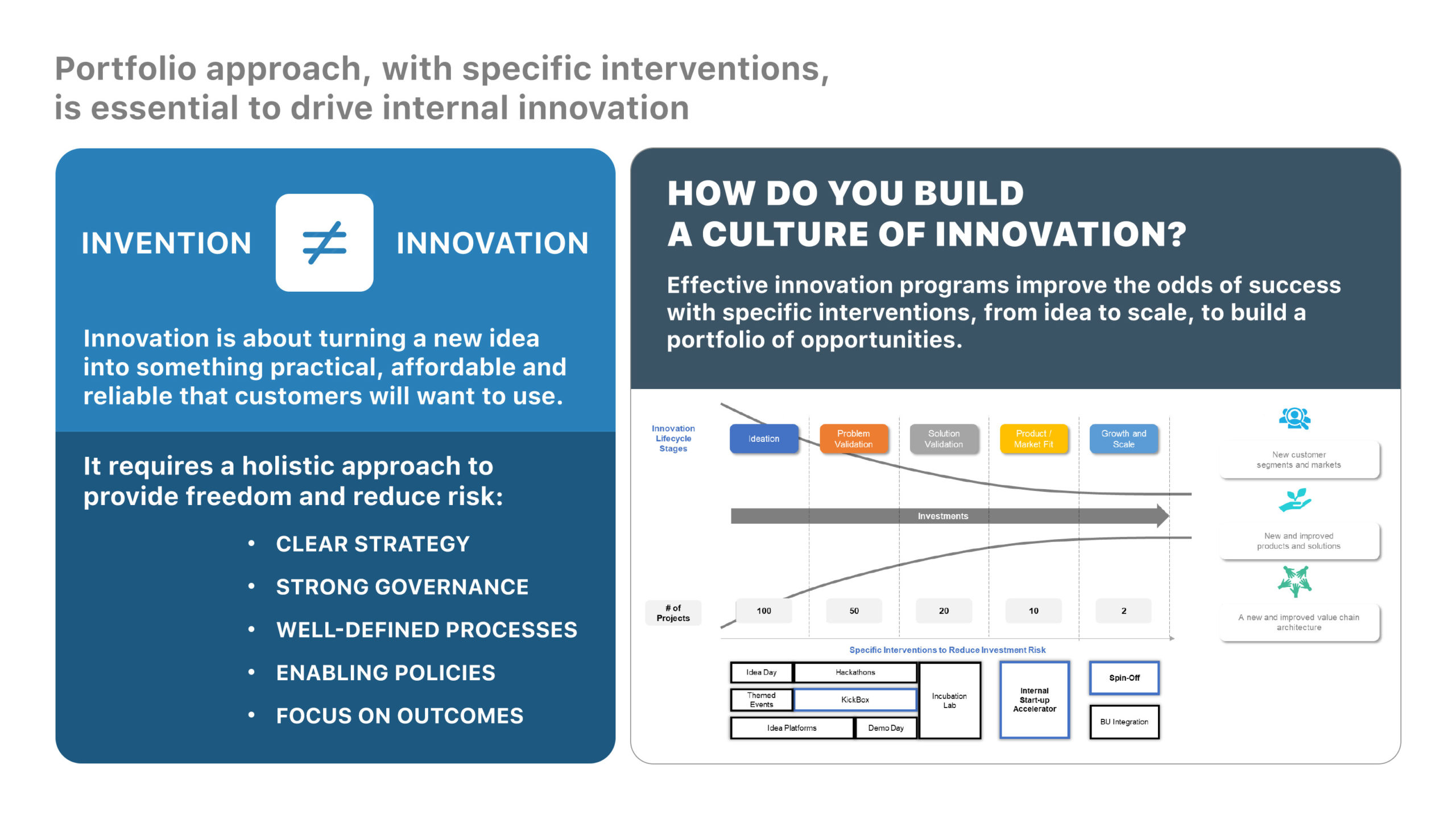
One critical thing to ensure is that the innovation programs are aligned with business outcomes.
To augment the GBS’ internal innovation efforts is to collaborate with start-ups. Billions of dollars spent by venture capital (VC) firms on cutting-edge start-ups across the world. The fact that GBS organizations have a presence in various global locations provides them an opportunity to tap into the creative force of thousands of start-ups and augment their internal innovation efforts. Many start-ups have great ideas but need access to patient customers who are willing to experiment and coach them.
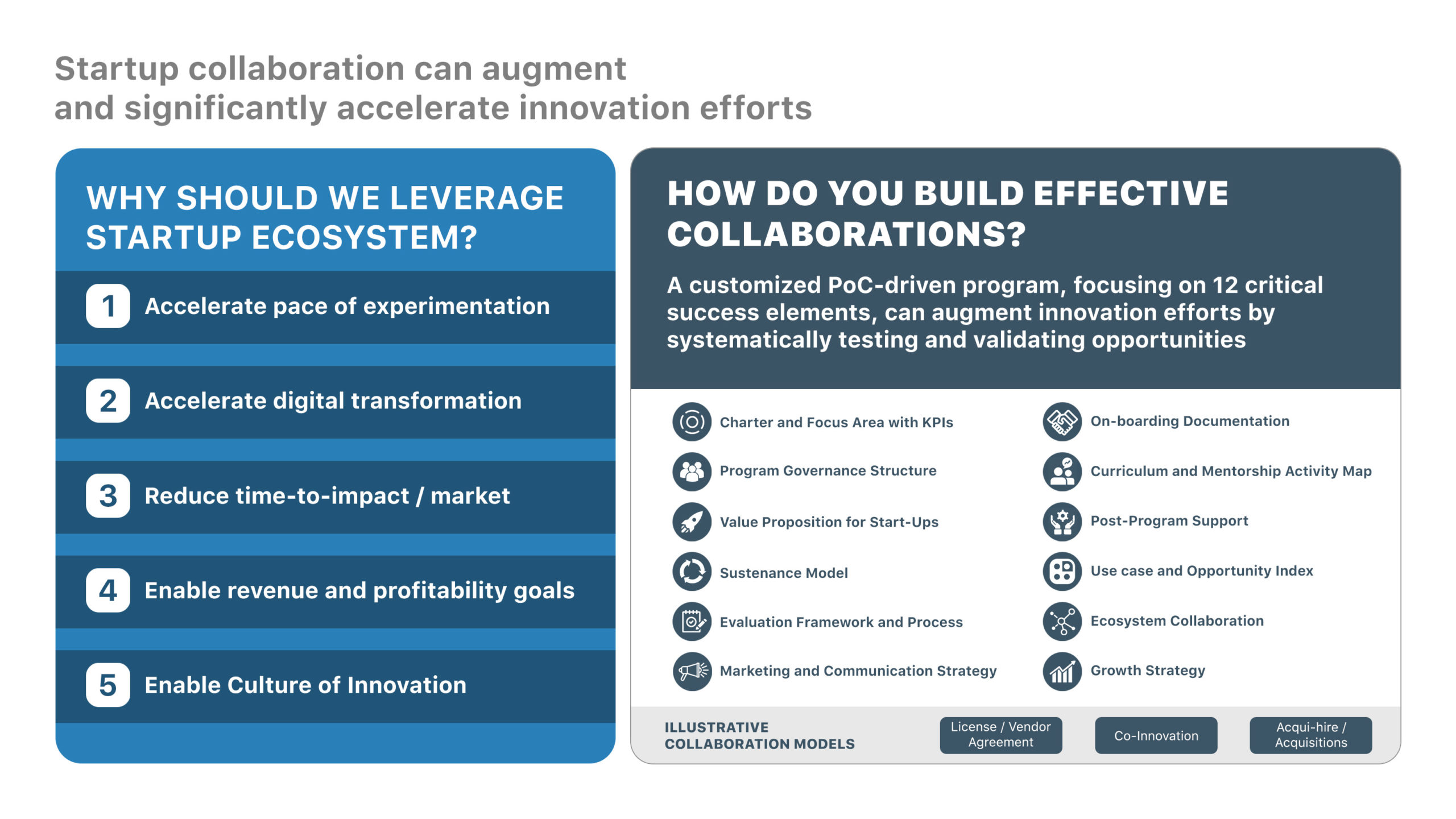
That’s where the corporate-start-up collaboration will come into play. Through custom designed, proof of concept (POC) driven structured programs, GBS organizations can leverage a variety of collaboration models such as co-innovation, license or vendor agreement, or even acquisitions.
The final pillar for GBS organizations to successfully transition into the 2.0 avatar is the right leadership at the helm. There are two major types of leaders – governors and intrapreneurs. While a governor is someone who maintains status quo and acts as a statesman, an intrapreneur takes initiative, is capable of internally navigating the company, is able to build convincing narratives about the initiatives undertaken, and is willing to put their job on the line.
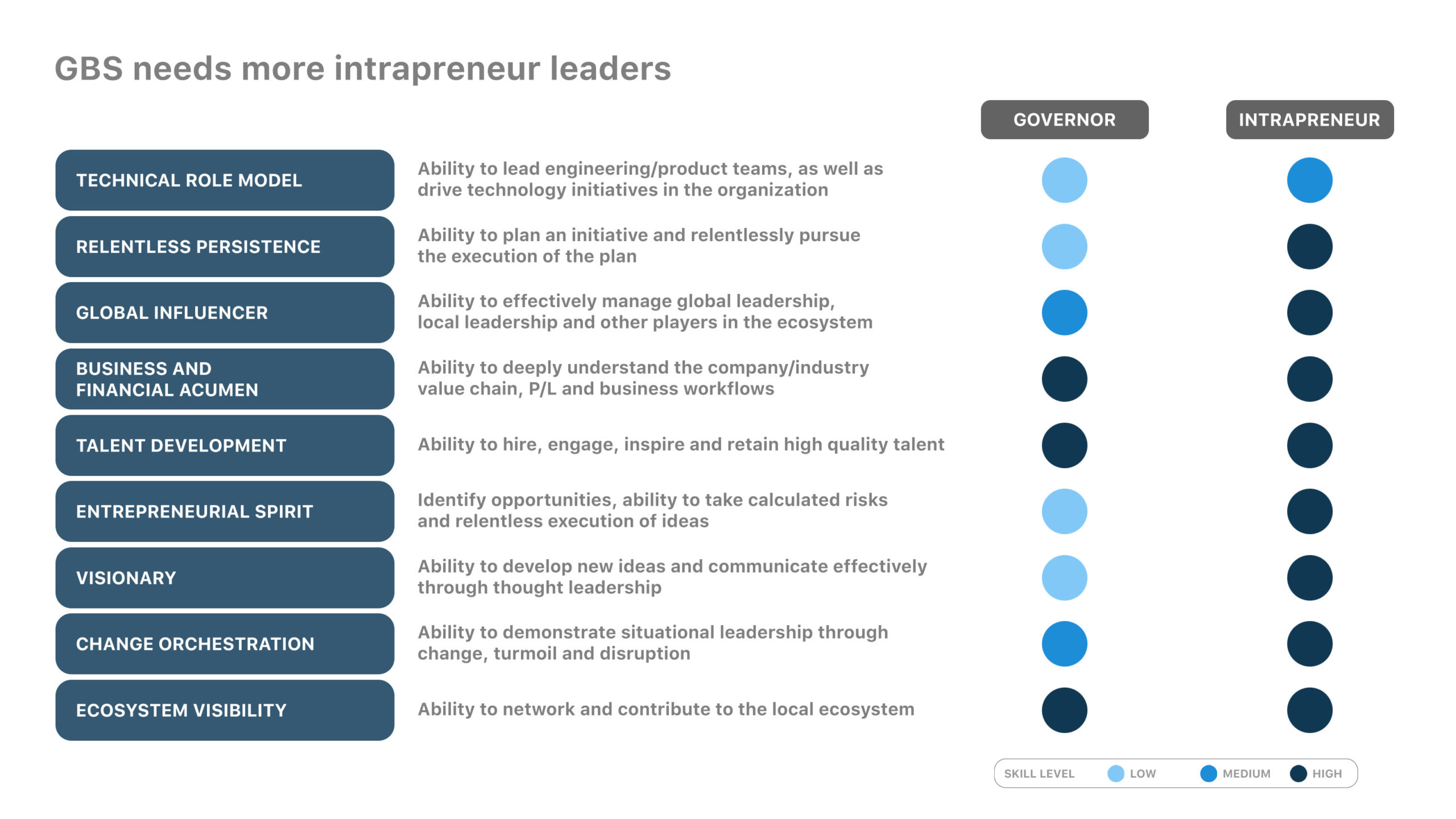
Intrapreneurs act as corporate entrepreneurs. Being an intrapreneur is about the right mindset; most leaders who are governors, have the capability to become intrapreneurs only if they get out of their comfort zone.
As companies grapple with this evolution of their GBS organizations, they will realize that Shared Services centers will play an integral part in their growth and scale. As we step into the next normal – a business reality forever-altered by the pandemic – GBS organizations will become strategic partners and will drive enterprise agility, speed, and innovation. However, there are still very many questions that we don’t yet have answers to –
Though we don’t yet have answers to these pertinent questions, the GBS space promises an interesting decade ahead, with infinite possibilities.
Global Business Services (GBS) is a centralized entity that comprises of shared services and centers of excellence (COEs) to carry out multiple business unit functions. GBS units run like any other business and act like partners to the organization with complete control of the processes.
Nearshoring is the practice of getting services delivered from a near or an adjacent location due to the significant time zone overlap and distance proximity. Offshoring is the process where operations and supporting functions are shifted to locations with affordable cost, proximity to resources, available affordable talent, and favorable government benefits.
Global Centers of Excellence (GCoE) are innovation hubs that provide strategic excellence and niche expertise to large organizations. GCoE is a transformation center that comprises of skilled teams solely dedicated to providing capabilities for product development, new innovation, and project management.